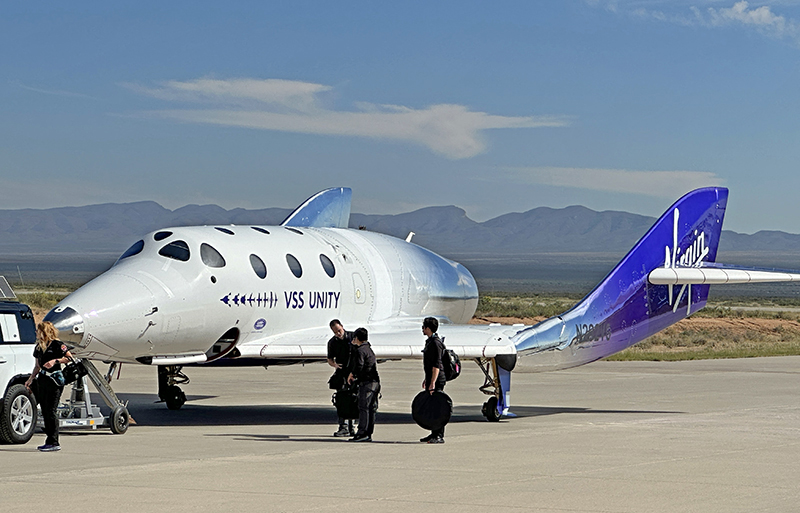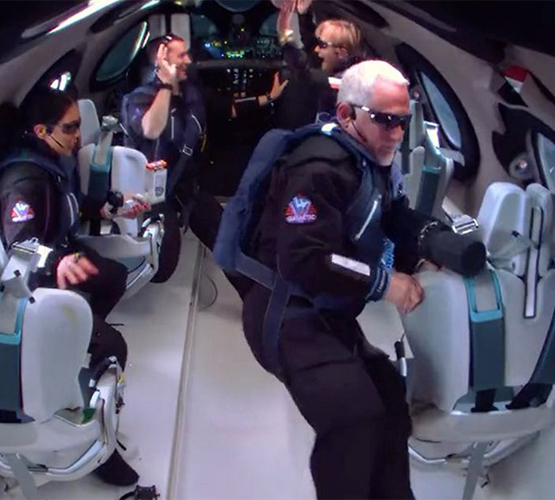Background
In 2023, P.I. Stern flew aboard the Virgin Galactic commercial spaceship Unity on a suborbital space mission. During the roughly 60-minute mission, first mated to its carrier aircraft VMS Eve, and then horizontally launched into space, Stern tested equipment and trained for a future suborbital flight where he will conduct two NASA experiments in space. Research applications for new generation suborbital vehicles include but are not limited to microgravity sciences, space life sciences, Earth and space sciences, land use, education and public outreach (EPO), technology development and demonstration/space systems development and demonstrations (including Technology Readiness Level [TRL] raising). The primary research advantages of these vehicles include more frequent access to the space environment, lower launch cost compared to conventional sounding rockets, capability for human operator presence, better experiment affordability, gentler ascent and entry compared to sounding rockets, and extended periods of turbulence-free microgravity.
Approach
Our long-term business interests in these vehicles are:
- To exploit them for planetary, astronomical, microgravity, aeronomical, and auroral research.
- To provide research-related common systems (flight computers, data recording racks, etc.) and payload integration services to NASA and/or vehicle providers.
- And to provide instrumentation, payload specialists, and flight project expertise to research groups, both domestic and overseas, working in this area.
Therefore, the overarching objective for this IR is to put SwRI in the lead of the burgeoning suborbital research field using next-generation, manned vehicles by becoming one of the first, and quite possibly the first, organization to fly payloads with research payload specialists on these vehicles. This will open up SwRI to a series of new business opportunities including new funded research projects, new hardware development projects, ground and flight system task order contracts associated with next-generation suborbital work, and the provision of payload specialists for next-generation suborbital work.
Accomplishments
- Selected our flight experiments (SWUIS-A [Southwest Ultraviolet Imaging System-Airborne] for remote sensing; biomed harnesses for life science work; BORE [Box-Of-Rocks Experiment] for microgravity research).
- Secured personnel for SWUIS-A refurbishment, checkout, and calibration.
- Began the refurbishment of SWUIS-A.
- Completed the design and initiated construction of the BORE microgravity experiment.
- Received and test fit a commercial biomed hardness that forms the basis of one of our three suborbital flight investigations.
- Initiated discussions with XCOR Aerospace, Virgin Galactic and Space Adventures about flight assignments, terms, and conditions, on their suborbital vehicles.
- Constructed a flight requirements matrix to determine which flight providers are suitable for which of our experiments.
- Completed a second set of F-104 training flights, with focused, in-flight investigations to (1) evaluate the wearability and function of the biomedical harness with standard crew flight suits and life support equipment during typical g-loads, and (2) test the design concept for our BORE microgravity experiment during zero-g parabolas.
- Completed a zero-g training flight that included initial zero-g training for Co-I Olkin and team exercises to refamiliarize/practice personal mobility and experiment handling operations in zero-g conditions.
- Oral presentations on the SwRI Suborbital Program and our three suborbital experiments at the Next-Generation Suborbital Researchers Conference (Orlando, FL).
- Completed construction of the BORE microgravity experiment.
- Successful pass of vibration testing of the Blue Origin configuration of the BORE microgravity experiment.
- Continued refurbishment and testing of SWUIS-A.
- Gave invited oral presentation on the SwRI Suborbital Program at Spacefest III (Tucson, AZ).
- Completion of FAA Class II and Class I medicals for each SwRI Payload Specialist in order to maintain expected suborbital flight medical qualification standards.
- Designed and press released the SwRI Payload Specialist Team mission patch.
- Initiated discussions with David Clark Company and NASTAR (National Aerospace Training and Research Center) on a collaborative effort to test/evaluate the CHAPS (Contingency Hypobaric Astronaut Protective Suit) pressure suit under launch g-loads.
- PI Stern completed pressure suit familiarization training at the David Clark Company and both PI Stern and Co-I Durda undertook centrifuge training at NASTAR to test/evaluate the David Clark CHAPS pressure suit under launch g-loads.
- Completed an upgrade and re-calibration of SWUIS experiment for flight.
- Initiated planning for high altitude (75,000 ft) flight training in F-104 and F-18 aircraft.
- Negotiated early flight test phase spaceflights with XCOR Aerospace.
- Continued aerobatic jet aircraft training for PI Stern and Co-I Durda; first introduction to aerobatic training for Co-I Olkin.
- Completed flight data requirements and collection plans for each suborbital experiment.
- Gave invited oral presentation on the SwRI Suborbital Program at AIAA (American Institute of Aeronautics and Astronautics) annual meeting (Nashville, TN).
- Gave oral presentations on the SwRI Suborbital Program and our three suborbital experiments at the Next-Generation Suborbital Researchers Conference (Palo Alto, CA).
- Gave invited oral presentation on the SwRI Suborbital Program at Spacefest IV (Tucson, AZ).
- Gave invited panel presentation and discussion on the SwRI Suborbital Program at Spaceup Houston 2012 Commercial Spaceflight event (Houston, TX).
- Met with flight providers XCOR Aerospace and Virgin Galactic to obtain flight integration timelines and experiment documentation flight requirements (Feb 2013).
- Requested and received flight integration requirements documents and initiated work to complete these documents.
- Clarified crew training requirements with both XCOR Aerospace and Virgin Galactic.
- Checked out all three of our flight experiments after over a year in storage.
- PI Stern and Co-I Durda reported on the progress of SwRI’s commercial suborbital program at the NSRC-2013 meeting (250+ participants).
- Attended September 2013 meeting in Mojave, CA for Virgin Galactic flight customers.
- Co-I Durda presented three public talks on the SwRI Suborbital Program at local clubs/organizations.
- PI Stern attended an invited panel presentation and discussion on the SwRI Suborbital Program at Spaceup Houston 2013 Commercial Spaceflight event (Feb 2013 in Houston, TX).
- Received the latest version of the XCOR Aerospace Lynx Payload User’s Guide (September 16, 2013 – v.4)
- PI Stern and Co-Is Durda and Olkin participated in a workshop on planetary science applications in suborbital science at the annual Division for Planetary Sciences meeting (6 Oct 2014 in Denver, CO).
- Built BORE and SWUIS experiment flight boxes and developed flight checklists, conducted a successful test of both experiments and validated checklists in zero-gravity parabolic aircraft flights flown by PI Stern, and CoIs Olkin and Durda.
- A two-year no-cost extension was approved by Mr. Downing in December 2014, extending the project to 1 January 2017.
- Co-I Durda presented a TEDx talk in Boulder on the SwRI Suborbital Program at the end of September 2014. The talk was attended by 2200 people and is archived online at https://www.youtube.com/watch?v=XzWDEkDAEMk.
- Conducted annual battery change for the biomonitor flight experiment (required annual maintenance to prevent loss of programmed settings).
- Site visit to check vehicle status and discuss flight test plans Virgin Galactic and XCOR Aerospace main facilities at Mojave Spaceport were completed in January 2016.
- Our BORE payload was prepared for flight aboard the Blue Origin New Shepard suborbital vehicle (including cleaning and reconfiguring internal parts after the November 2013 zero-g test flight, reconfiguring for new data cameras provided by Blue Origin, reprogramming and testing the new flight software after delivery from Blue Origin of a new Benchtop Payload Controller, etc.).
- BORE successfully flew its first suborbital spaceflight aboard Blue Origin’s New Shepard rocket on 2 April, 2016. The payload performed flawlessly and recorded high-quality video data of the settling behavior of two different asteroid regolith simulants in microgravity. This was the first flight of science payloads on New Shepard and Blue Origin marked the event by broadcasting pre-recorded video ‘tours’ of the experiments; SwRI’s contribution is archived online at https://www.youtube.com/watch?v=dugpPEp2y78.
- Held 5th Next Generation Suborbital Researchers Conference in June 2016, further cementing SwRI’s role as a leader in suborbital research and education.
- A site visit to Blue Origin’s headquarters and rocket/capsule factor was conducted by the PI and both CoIs on 31 March 2017. We found that the vehicle meets all necessary technical specifications for our three experiments and our payload specialists. In August 2019, we began discussions with Blue Origin to fly SwRI payloads and payload specialists and visited Blue Origin HQ to discuss a flight contract.
- Initiated early discussions with two new flight providers for suborbital flights.
- Held a very successful 6th Next Generation Suborbital Researchers Conference in December 2017, with 240 participants, all excited about upcoming commercial suborbital opportunities.
- Placed World View high altitude ballooning under contract for a research flight. That research flight was successfully flown in November 2019.
- Continued contract discussions with Blue Origin.
- Co-I Durda participated in a panel discussion on “Why we want to fly in space” with other astronauts and future astronauts at the 2019 International Astronautical Congress in Washington, DC on 23 October 2019.
- Held the 7th Next Generation Suborbital Researchers Conference in March 2020, further cementing SwRI’s role as a leader in suborbital research and education.
- Co-I Durda proposed and was awarded a NASA Tech Flights program grant to conduct a second suborbital spaceflight of our BORE asteroid regolith microgravity experiment on Blue Origin’s New Shepard rocket. Launch occurred in October 2020 with a 100% successful BORE II mission.
- Proposed to NASA for $300K in support of SwRI IRAD experiments to be flown on Virgin Galactic’s SpaceShipTwo. PI Stern was awarded the first NASA human-tended flight mission and flight details are being negotiated with Virgin Galactic for flight in 2022.
- PI Stern participated in two Zero-G parabolic flights in 2021 (Denver in May and NYC in Sep), maintaining zero-g proficiency in the run-up to his NASA human-tended research flight.
- A no-cost extension was approved by Mr. Downing, extending the project to 1 January 2023.
- In September, 2021 we began negotiating our second flight date with Virgin Galactic. Present plans are for flights in late 2022 and early-mid 2023.
- In September 2021, PI Stern undertook another Zero-G training flight.
- In December 2021, agreed to terms and conditions for a two flight sequence with Virgin Galactic and discussions of a first spaceflight with Blue Origin were initiated.
- In February 2022, we re-initiated discussions with Blue Origin for a near term SwRI flight.
- In May 2022, we completed and delivered the Virgin Galactic Payload Information Form (VIF) for our first flight.
- Throughout late summer and early autumn 2023 we began working with the Virgin galactic team to complete our Payload Information Package (PIP) for our first flight. PI Stern also began a number of in-depth familiarization and ‘meet your crew’ meetings with Virgin Galactic.
- In August 2023, PI Stern attended the Virgin Galactic G02 launch and met with the payload team for his upcoming flight.
- In September 2023 Co-I Durda completed turn-on validation of the bioharness and fabrication of a number of foam mockups for the Xybion camera that PI Stern will use during his first flight.
- In September 2023 PI Stern and Co-I Durda underwent centrifuge training, flying the Virgin Galactic flight profile, during suborbital spaceflight refresher training at the NASTAR Center in Philadelphia.
- In early October 2023 Co-I Durda attended the Virgin Galactic G04 launch and met with the payload team to refine final PIP details.
- On October 18, 2023 Virgin Galactic officially announced that the launch window for Virgin Galactic G05 will open on November 2, 2023, with PI Alan Stern aboard as Astronaut 020.
- On November 2, 2023, P.I. Stern flew aboard the Virgin Galactic commercial spaceship Unity on a suborbital space mission. All objectives were accomplished.

Figure 1: Co-I Durda photographed the Unity spacecraft towing back to the hangar after its successful G04 spaceflight on Friday October 6, 2023.

Figure 2: P.I. Stern aboard the Virgin Galactic commercial spaceship Unity. All objectives were accomplished.
